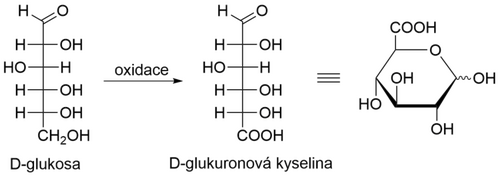Conversion of glucose to glucuronic acid
Glucuronic acid belongs to the so-called uronic acids, basic components of many important substances for the body - for example, glycosaminoglycans , and therefore also proteoglycans. In addition, uronic acids are also used as conjugation agents facilitating the excretion of many endogenous and foreign substances. In addition to glucuronic acid, uronic acids also include L -iduronic or galacturonic acid.
The formation of glucuronic acid from glucose consists the oxidation of the primary hydroxyl group at C6 of the glucose molecule to a carboxyl group.
But before the oxidation itself, the glucose molecule must first be converted into the active form – UDP-glucose . The individual steps of the conversion of glucose into glucuronic acid take place as follows:
But before the oxidation itself, the glucose molecule must first be converted into the active form – UDP-glucose . The individual steps of the conversion of glucose into glucuronic acid take place as follows:
1) Phosphorylation of glucose (catalyzed by hexokinase/glucokinase):
- glucose + ATP → glucose-6-phosphate + ADP
2) Glucose isomeration (catalyzed by glucose phosphate isomerase):
- glucose-6-phosphate → glucose-1-phosphate
3) Glucose activation - UDP binding (catalyzed by UDP-glucose pyrophosphorylase):
- glucose-1-phosphate + UTP → UDP-1-glucose + diphosphate
4) Oxidation to glucuronate:
- UDP-1-glucose + 2 NAD+ → UDP-glucuronate + 2 NADH+H+
- UDP-glucuronate is the active form of glucuronic acid and can enter into many reactions.

